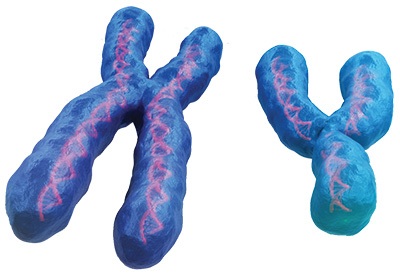 What does the Bible tell us about the age of the earth? Not only does the Bible describe how God created Earth and its life forms in six days, Genesis also contains detailed genealogies and chronologies. Based on the Hebrew Masoretic text, one can deduce Earth’s age to be about 6,000 years.1,2 In contrast, evolutionists believe Earth is 4.6 billion years old and that life here got going about 3.5 billion years ago.
What does the Bible tell us about the age of the earth? Not only does the Bible describe how God created Earth and its life forms in six days, Genesis also contains detailed genealogies and chronologies. Based on the Hebrew Masoretic text, one can deduce Earth’s age to be about 6,000 years.1,2 In contrast, evolutionists believe Earth is 4.6 billion years old and that life here got going about 3.5 billion years ago.
While the evolutionary story is just naturalistic speculation, the Bible gives a fairly complete history and timeline that provide the basis for what is often called a young-earth creationist view. But do the scientific facts demonstrate a young age for Earth? This article will show that a young earth is well supported by the biological data.
A young earth is well supported by the biological data. ![]()
1. Soft Tissues and Biomolecules in Fossils
 Soft tissues and decay-sensitive biomolecules that are still intact and not degraded shouldn’t exist in fossils that are supposedly millions of years old—but they do. The most famous case of this evolutionary enigma was the discovery of soft, stretchy tissue in the bones of a T. rex, along with visible blood vessels, blood cells inside the vessels, and bone cells with delicate finger-like projections called osteocytes.3,4 Collagen proteins were also found in the T. rex bones. Similar finds have been discovered in other dinosaur fossils, including a hadrosaur and a Triceratops.5,6
Soft tissues and decay-sensitive biomolecules that are still intact and not degraded shouldn’t exist in fossils that are supposedly millions of years old—but they do. The most famous case of this evolutionary enigma was the discovery of soft, stretchy tissue in the bones of a T. rex, along with visible blood vessels, blood cells inside the vessels, and bone cells with delicate finger-like projections called osteocytes.3,4 Collagen proteins were also found in the T. rex bones. Similar finds have been discovered in other dinosaur fossils, including a hadrosaur and a Triceratops.5,6
ICR research scientist Brian Thomas has compiled a list of 41 different journal papers describing the amazing soft tissues and biomolecules discovered in the fossils of many different types of land and sea animals and plants.7 Many of these findings were made and documented by secular scientists. Some of these discoveries involve fossils alleged to be 250 to 550-plus million years old. Because it would be impossible for these highly degradable compounds to last for more than a few thousand years, the evidence clearly points to a young age for Earth and to the global Flood that produced the fossilized remains, burying them quickly in sediments about 4,500 years ago.
2. Ancient Microbe Resurrections
 Since the mid-1990s, scientists have isolated and characterized more than 1,200 ancient microorganisms extracted from fossils found in amber.8 These amber fossil finds include nine ancient yeasts, four of which are brewer’s yeasts that were patented and used to commercially brew beer by one of the scientists who discovered them. These amber-extracted microbes were thought to be up to 40 million years old.
Since the mid-1990s, scientists have isolated and characterized more than 1,200 ancient microorganisms extracted from fossils found in amber.8 These amber fossil finds include nine ancient yeasts, four of which are brewer’s yeasts that were patented and used to commercially brew beer by one of the scientists who discovered them. These amber-extracted microbes were thought to be up to 40 million years old.
But the most amazing microbe discovery came when scientists were able to revive bacteria extracted from salt inclusions in rock strata that were alleged to be 250 million years old.9 A salt inclusion is a pocket of salty water that became trapped as the sedimentary rock formed, a phenomenon that would have occurred during the Genesis Flood. Based on an evolutionary perspective of the rock strata, scientists dated the salt inclusion layer as early Triassic. Needless to say, these ancient resurrected microbes shouldn’t have been present if the rocks were actually that old. Their existence points to a young earth and a recent global flood.
3. Degeneration of the Human Genome
 Contrary to popular evolutionary dogma, the human genome is actually degrading over time. It’s devolving, not evolving. At the beginning of creation, Adam and Eve’s genomes would have been pristine, with no errors. Then they both fell into sin and brought a curse upon creation, causing increasing amounts of DNA decay and progressive loss of genetic information in successive generations of their offspring. This degeneration is due to multiple slightly harmful mutations that occur during each generation, and the accumulation rate of these genetic alterations is indicative of a human origin in agreement with the biblical chronology of about 6,000 years.
Contrary to popular evolutionary dogma, the human genome is actually degrading over time. It’s devolving, not evolving. At the beginning of creation, Adam and Eve’s genomes would have been pristine, with no errors. Then they both fell into sin and brought a curse upon creation, causing increasing amounts of DNA decay and progressive loss of genetic information in successive generations of their offspring. This degeneration is due to multiple slightly harmful mutations that occur during each generation, and the accumulation rate of these genetic alterations is indicative of a human origin in agreement with the biblical chronology of about 6,000 years.
In fact, as I have documented previously, empirical genetic clocks determined by both secular and creation researchers indicate a beginning point of human variation associated with degeneration starting about 5,000 to 10,000 years ago.10,11 This recent time frame also fits closely with a pattern of human life expectancy that quickly and continually declined after the global Flood.
4. Evidence for Mitochondrial Eve and Recent Origin of Y-Chromosome Adam

Outside the nucleus of the human cell, small organelles called mitochondria act as energy factories. Each mitochondrion contains a small piece of circular DNA that is typically inherited only through the mother. Scientists have studied mitochondrial DNA in people groups around the world and discovered the data are consistent with a single origin of all humans less than 10,000 years ago.10,11 Creation scientist and geneticist Robert Carter reconstructed a consensus mitochondrial DNA sequence for the original ancestral “Eve” and published the results in a peer-reviewed secular journal.12,13
An individual’s biological gender is genetically determined by inherited sex chromosomes—XY for males and XX for females. At conception, a male embryo gets a Y chromosome from the father’s sperm cell and an X from the mother’s egg cell. A female gets an X from the father and an X from the mother. The Y chromosome stimulates the development of male traits.
As it turns out, there is a very limited amount of variation in the DNA sequence for the human Y chromosome across the world’s population. This is consistent with an origin of humanity only about 6,000 years ago.14 In fact, the same recent origin of the Y chromosome followed the same pattern of variation observed in the mitochondrial DNA sequence. This matches the human history found in Genesis.
5. Unchanged Living Fossils (Stasis)

Creatures like jellyfish, graptolites, horseshoe crabs, coelacanths, and many more are living proof of a recent creation.15 How could so many types of creatures remain so unchanged during the alleged millions of years attributed to evolution? Called living fossils—a term coined by Darwin—they form discontinuous fossil sequences in that they appear suddenly in the fossil record without any evolutionary precursors, disappear and apparently go extinct, and yet are still living today. For example, horseshoe crabs show up in the fossil record 450 million years ago (according to evolutionary dating) and then disappear for hundreds of millions of years but are alive now. Evolutionists like to call this a “Lazarus effect.”
One living fossil tree, the Wollemi pine, supposedly first showed up in the fossil record over 200 million years ago and not only still exists but has living specimens dated at less than 1,000 years. The lack of evolution observed in living fossils, combined with their sudden appearance in the fossil record and then absence for millions of years, doesn’t support the evolutionary paradigm. Instead, the fossil record shows that a global flood occurred only thousands of years ago and progressively buried ecosystems.16 Living fossils are more evidence that Earth is quite young.
6. Population Growth

According to the evolutionary timeline, humans diverged from a chimp-like ancestor three to six million years ago. In that case, there ought to be many billions of people living today or buried in the fossil record. With the world’s human population now approaching eight billion, the evolutionary story falls completely short—there should be many more of us.
As it turns out, a biblical model of Earth being repopulated from Noah’s three sons and their three wives starting about 4,500 years ago fits perfectly with the number of people living today. In 2015, Robert Carter and Chris Hardy used computer modeling for population growth that included multiple variables like age of reaching maturity, minimum child spacing between births, and age of menopause.17 They also factored in probabilities like polygamy, twinning rates, and the risk of death according to age. Their conclusion was that “it is trivial [i.e., no great difficulty] to obtain the current world population from three founding couples in four and a half millennia.”17
These six biological evidences provide ample support for a young earth. There are numerous examples in every arena of science, and more are discovered each year.
References
- Johnson, J. J. 2008. How Young Is the Earth? Applying Simple Math to Data in Genesis. Acts & Facts. 37 (10): 4-5.
- Hardy, C. and R. Carter. 2014. The biblical minimum and maximum age of the earth. Journal of Creation. 28 (2): 89-96.
- Schweitzer, M. H. et al. 2005. Soft-Tissue Vessels and Cellular Preservation in Tyrannosaurus rex. Science. 307 (5717): 1952-1955.
- Schweitzer, M. H., J. L. Wittmeyer, and J. R. Horner. 2007. Soft tissue and cellular preservation in vertebrate skeletal elements from the Cretaceous to the present. Proceedings of the Royal Society B. 274 (1607): 183-197.
- Schweitzer, M. H. et al. 2009. Bimolecular Characterization and Protein Sequences of the Campanian Hadrosaur B. canadensis. Science. 324 (5927): 626-631.
- Armitage, M. H. and K. L. Anderson. 2013. Soft sheets of fibrillar bone from a fossil of the supraorbital horn of the dinosaur Triceratops horridus. Acta Histochemica. 115 (6): 603-608.
- Thomas, B. Published Reports of Original Soft Tissue Fossils. Posted on ICR.org September 17, 2018.
- Thomas, B. ‘45-Million-Year-Old’ Brewer’s Yeast Still Works. Creation Science Update. Posted on ICR.org August 17, 2009.
- Vreeland, R. H., W. D. Rosenzweig, and D. W. Powers. 2000. Isolation of a 250 million-year-old halotolerant bacterium from a primary salt crystal. Nature. 407 (6806): 897–900.
- Tomkins, J. P. 2014. Genetic Entropy Points to a Young Creation. Acts & Facts. 43 (11): 16.
- Tomkins, J. P. 2015. Genetic Clocks Verify Recent Creation. Acts & Facts. 44 (12): 9-11.
- Carter, R. 2009. The Neutral Model of evolution and recent African origins. Journal of Creation. 23 (1): 70-77.
- Carter, R. W. 2007. Mitochondrial diversity within modern human populations. Nucleic Acids Research. 35 (9): 3039-3045.
- Carter, R. W., S. S. Lee, and J. C. Sanford. 2018. An overview of the independent histories of the human Y chromosome and the human mitochondrial chromosome. In Proceedings of the Eighth International Conference on Creationism. J. H. Whitmore, ed. Pittsburgh, PA: Creation Science Fellowship, 133-151.
- Guliuzza, R. J. 2016. Major Evolutionary Blunders: The Fatal Flaws of Living Fossils. Acts & Facts. 45 (6): 16-18.
- “The geological column and its accompanying fossils represent the progressive extinctions and rapid ebb and flow of water burying entire ecosystems over the course of the flood year.” Tomkins, J. P. and T. L. Clarey. Red Algae Lazarus Effect Can’t Resurrect Evolution. Creation Science Update. Posted on ICR.org January 31, 2019.
- Carter, R. and C. Hardy. 2015. Modelling biblical human population growth. Journal of Creation. 29 (1): 72-79.
*Dr. Tomkins is Director of Life Sciences at the Institute for Creation Research and earned his Ph.D. in genetics from Clemson University.














